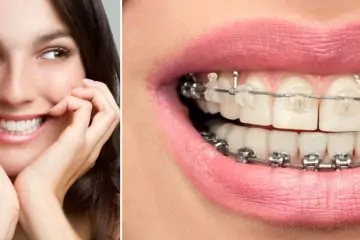Removing vinyl glue or adhesive residue from concrete floors can be an extremely frustrating and challenging task. Whether you’re getting rid of old vinyl tiles, sheet flooring, or carpet, the stubborn adhesive left behind on the concrete surface needs to be removed properly before installing any new flooring. Failing to do so can prevent proper adhesion and lead to premature failure of the new floor covering or coating.
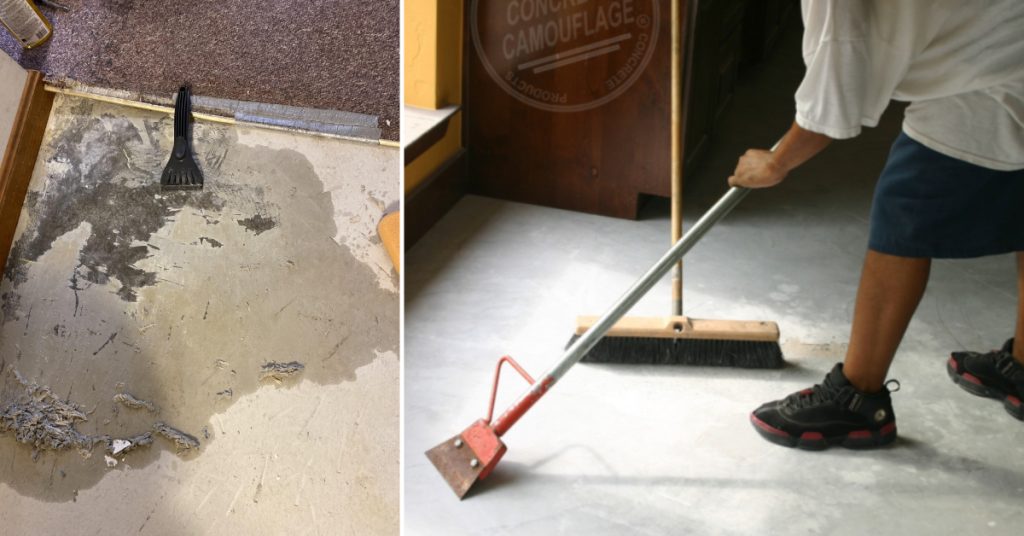
In this comprehensive guide, we’ll cover all the essential methods, tools, and techniques you need to effectively how to remove vinyl glue from concrete. We’ll dive into mechanical removal processes like scraping, sanding, and grinding, as well as chemical removal using solvents and eco-friendly adhesive removers. We’ll also discuss the importance of proper preparation, safety precautions, and post-removal cleaning to ensure a successful outcome.
Key Takeaways:
- Identify the adhesive type for effective removal
- Use mechanical (scraping, sanding, grinding) and chemical removal methods
- Prioritize safety with proper ventilation and protective gear
- Thoroughly clean and prepare the surface post-removal
Preparing for the Removal Process
Before starting the vinyl glue removal process, it’s crucial to identify the type of adhesive you’re dealing with. Different adhesives may require different removal methods and products. Common types include latex-based, solvent-based, and epoxy adhesives. Consulting the product label or manufacturer can help you determine the adhesive type, which will guide your approach.
Next, gather the necessary tools and materials. You may need scraping tools like putty knives or floor scrapers, sanding or grinding equipment (hand-held or larger floor grinders), chemical removers or solvents, and protective gear such as gloves, goggles, and respirators.
Safety should be a top priority throughout the removal process. Ensure proper ventilation in the work area, especially when using chemical solvents or grinding equipment that can create dust. Follow all safety guidelines for handling chemicals and using power tools or equipment.
3 Trustworthy Methods for How to Remove Vinyl Glue From Concrete
Here are 3 trustworthy methods for how to remove vinyl glue from concrete:
Method 1: Mechanical Removal Methods
A. Scraping
For thick layers or large areas of adhesive, scraping can be an effective starting point. Use a sharp floor scraper or putty knife to manually scrape off as much of the vinyl glue as possible. This method requires significant elbow grease but can remove a substantial amount of the adhesive.
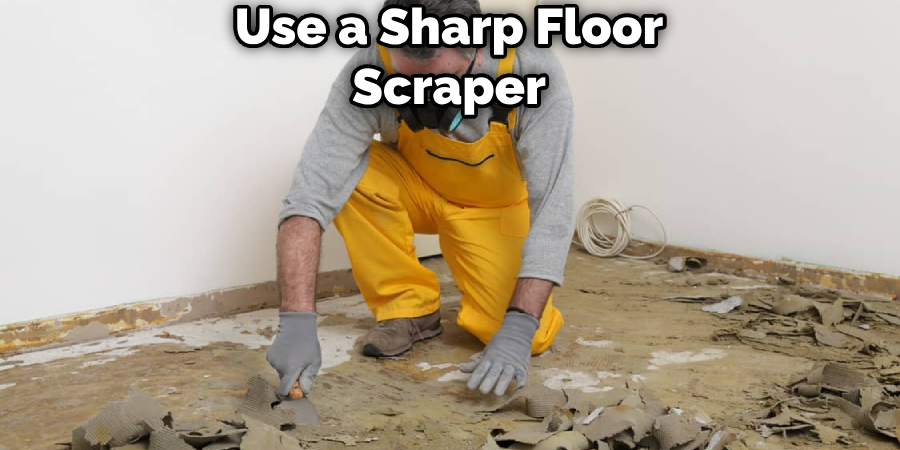
B. Sanding
Sanding is a suitable option for thinner layers of adhesive or smaller areas. You can use hand sandpaper or power sanders, starting with coarse grits and progressively moving to finer grits until the desired smoothness is achieved. Be careful not to oversand and damage the concrete surface.
C. Grinding
For large areas or heavily adhered vinyl glue, a concrete grinder or floor polisher equipped with diamond abrasive pads or segments may be necessary. These powerful tools can effectively remove the adhesive by grinding away a thin layer of the concrete surface. Dust containment and collection systems are essential when grinding to prevent the inhalation of harmful concrete dust.
D. Using Heat
Applying heat can help soften and loosen stubborn vinyl glue, making it easier to scrape or sand off. Heat guns or irons can be used for this purpose, but exercise caution to avoid damaging the concrete surface or creating harmful fumes.
Method 2: Chemical Removal Methods
In cases where mechanical removal methods are ineffective or impractical, chemical solvents or adhesive removers can be employed to dissolve and soften the vinyl glue.
A. Solvent-based Removers
Solvents like acetone, mineral spirits, or paint thinners can effectively dissolve vinyl glue and other adhesives. However, these products are highly flammable and can release harmful fumes, so proper ventilation and safety precautions are essential. Follow all handling and disposal guidelines carefully.
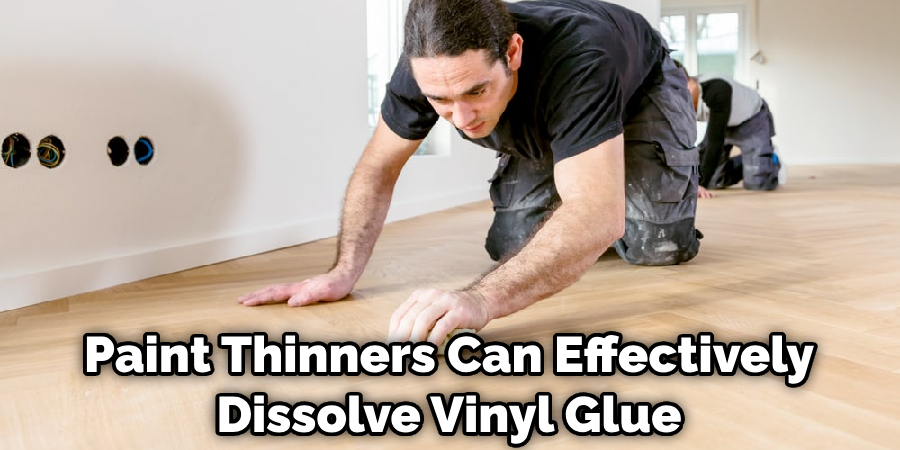
B. Eco-friendly/Bio-based Removers
Consider using eco-friendly or bio-based adhesive removers for a safer and more environmentally friendly option. These products are typically made from plant-based or biodegradable ingredients and are less hazardous than solvent-based removers, although they may be less effective on certain types of adhesives.
C. Application Techniques
It’s important to apply chemical removers evenly over the adhesive-covered area when using chemical removers. Follow the product instructions for dwell times and reapplication if necessary. Some adhesives may require multiple applications or longer dwell times to fully soften and dissolve.
D. Testing Removers
Before applying any chemical remover to a large area, testing it on a small, inconspicuous section of the concrete floor first is advisable. This will help you evaluate its effectiveness and ensure it doesn’t cause any discoloration or damage to the concrete surface.
Method 3: Combination Methods
In some cases, a combination of mechanical and chemical methods may be necessary to remove stubborn vinyl glue from concrete floors effectively. One approach is to use chemical removers first to soften and dissolve the adhesive, followed by scraping, sanding, or grinding to remove the loosened residue.
Alternatively, you can alternate between chemical and mechanical methods, using the chemical remover to soften the adhesive and then mechanical means to remove it, repeating the process as needed.
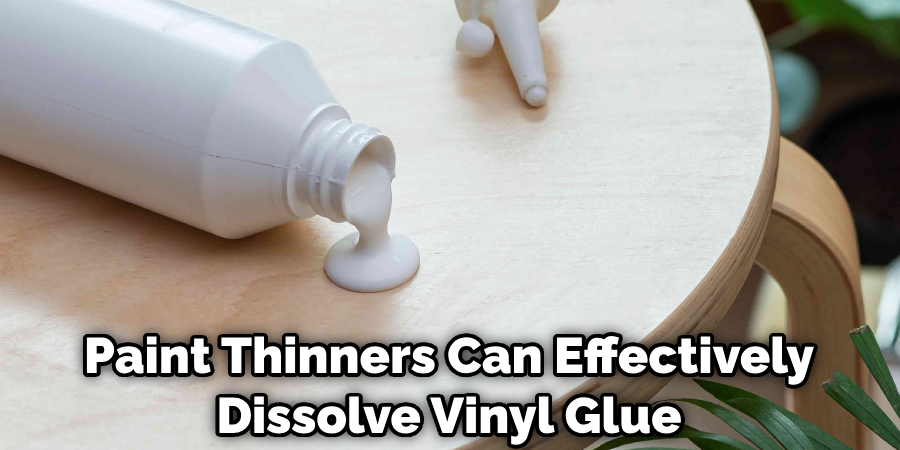
Combination methods are often the most effective approach for heavily adhered or thick layers of vinyl glue, as they leverage the strengths of both chemical and mechanical removal techniques.
You Can Check It Out to Remove Glue From Aluminum.
Post-Removal Cleaning and Preparation
Once you’ve successfully removed the vinyl glue from the concrete surface, it’s essential to thoroughly clean and prepare the area for any new flooring or coating.
First, remove any remaining adhesive residue using a concrete degreaser or pH-neutral cleaner and a scrub brush or floor scrubber. This step ensures a clean, contaminant-free surface for optimal adhesion.
Next, degrease and neutralize the concrete surface to ensure proper adhesion for the new flooring or coating. Follow the manufacturer’s recommendations for any specific cleaning or preparation requirements.
4 Tips and Tricks for How to Remove Vinyl Glue From Concrete
Here are some additional tips and tricks to help make the vinyl glue removal process smoother and more effective:
- For tough spots or heavily adhered areas, you may need to apply more elbow grease or use a combination of multiple removal methods.
- Work in manageable sections, especially for larger areas, to avoid the adhesive or removers from drying out before you can address them.
- Properly dispose of any waste materials, used solvents, or contaminated cleaning solutions according to local regulations.
- If the vinyl glue removal process seems overwhelming or you’re dealing with a large commercial space, consider hiring a professional concrete surface preparation company for assistance.
You Can Check It Out What Glue to Use for Artificial Grass on Concrete.
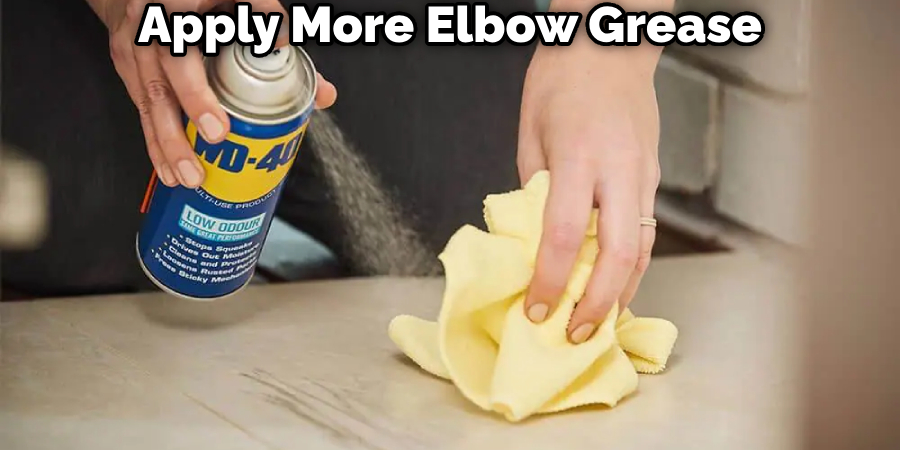
FAQs About How to Remove Vinyl Glue From Concrete
What Dissolves Vinyl Adhesive?
To dissolve vinyl adhesive effectively, you can use isopropyl alcohol, acetone, WD-40, white vinegar, and commercial adhesive removers like Goo Gone, or apply heat with a hair dryer or heat gun. Each method has its strengths, with alcohol and vinegar being milder options, while acetone and adhesive removers offer more strength but require cautious use to avoid damage to underlying surfaces. Always test your chosen solvent on a small, inconspicuous area first and ensure proper ventilation and protective measures are taken during application.
Does Vinegar Remove Vinyl Adhesive?
Yes, vinegar can remove vinyl adhesive. It is a mild acid that can help to soften and dissolve the adhesive, making it easier to wipe away or scrape off. Warm vinegar tends to be more effective, as the heat helps to loosen the adhesive bond. To use vinegar for this purpose, apply it generously to the adhesive residue, allow it to sit for several minutes to soften the adhesive, and then gently scrub or scrape the residue away. Vinegar is a safer, eco-friendly alternative to chemical solvents, but it may require a bit more effort and time to completely remove the adhesive.
What is the Best Adhesive Remover for Concrete?
For effectively removing adhesive from concrete, Goo Gone Pro-Power and Krud Kutter Adhesive Remover are top commercial-grade choices known for their efficacy without damaging surfaces. WD-40 and orange solvent-based removers offer a more versatile and eco-friendly approach but might require more application effort for stubborn adhesives. For particularly tough jobs, like removing carpet glue or tile mastic, heavy-duty mastic removers are recommended, though they should be used with caution due to their potent chemical composition. Regardless of choice, always prioritize safety by wearing protective gear, ensuring good ventilation, and testing the product on a small area first.
Conclusion
Removing vinyl glue from concrete floors can be a challenging task, but with the right techniques, tools, and perseverance, it is achievable. By following the steps outlined in this guide, including identifying the adhesive type, employing mechanical and chemical removal methods, practicing proper safety precautions, and thoroughly cleaning the surface post-removal, you can successfully prepare your concrete floors for a new covering or coating.
Remember, thorough adhesive removal is crucial for ensuring proper adhesion and long-lasting results for your new flooring or surface treatment. If you encounter particularly stubborn adhesive or have concerns, don’t hesitate to seek professional assistance to avoid damaging your concrete surface and achieve the desired outcome.
